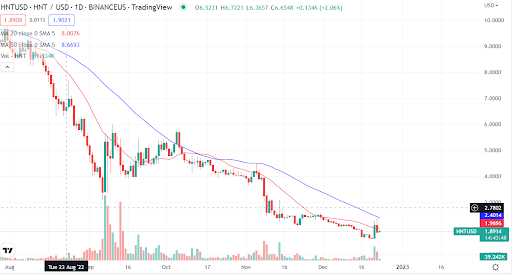
-
Helium token rose by 36% on Thursday before correcting
-
Helium powers IoT devices through its “hotspots”
-
The cryptocurrency remains on a clear downtrend
A few cryptocurrencies embarked on relief rallies on Thursday, although a low-cap coin was among the top gainers. Helium (HNT/USD), a cryptocurrency ranked #91 by market cap, rose by 36% before shedding nearly half of the gains by Friday. In an exceedingly bearish crypto market, the small-cap token warranted investors’ attention. What is it?
Helium is a blockchain-powered network that was created in July 2019. It is made to power Internet of Things devices. For instance, it enables wireless devices to communicate and share data through its nodes or “hotspots.” The network also lets users profitably earn by sharing their broadband.
You would be forgiven for thinking that Helium is less used. Companies that use the IoT technology service of Helium include Abeeway, Agulus, and Airly. The network has been witnessing increasing growth and now connects nearly 1,000k hotspots. In September, Helium announced a migration to Solana to grow its ecosystem. That was after more than 6,000 members voted in favour. The goal of moving to Solana was inspired by the need to cut reliance entirely on its network.
While Helium token price could be earning boosts from the recent changes, the price is unconvincing. Trading at just $2.0, HNT remains on a clear downtrend. The cryptocurrency has lost 96% of value since its $57 all-time high price in November 2021. The cryptocurrency faces resistance at the 50-day MA.
Helium token rejected at the 50-day MA

Helium outlook shows the price coming under pressure as it touched the 50-day MA. From the volume indicators, a price spike happened at $1.6, indicating that buyers were very active. The cryptocurrency traded with an intraday 1,500% jump in volumes at the bottom price.
What next for HNT?
Despite the intraday gains, HNT price lacks a clear path to recovery as the trend is still bearish. The gains could be a bull trap, especially after getting rejected at the moving averages.

